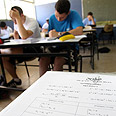
Education gap widening
צילום: רועי עידן
Matriculation results show widening gaps
Government data on high school diploma eligibility reveals that gap between central cities, periphery widening; haredi, Arab towns still trailing far behind
The 2011 matriculation exam results reveal that the education gap between prosperous cities in the center of Israel and haredi and Arab towns – who are trailing far behind – is growing.
Data published Wednesday by the Education Ministry on the 2011 exams also show that the city of Shoham is once again at the top of the matriculation exam rankings, with 86.2% eligible for a high school diploma, followed by Kochav Yair (84.82%), Hof Sharon Regional Council (82.2%), Kiryat Ono (81.5%) and Ra'anana (80.14%).
Related stories:
- Matriculation eligibility rate reveals gloomy picture
- Haredi exams receive ministry recognition
- Jewish, Arab parents for equal education
Bnei Brak, a city with a haredi majority, is at the bottom of the table together with haredi towns Beitar Illit and Kiryat Sefer – all three with only 10% of students eligible to receive a high school diploma.
The data shows that socio-economically strong cities continued to shine on the matriculation chart while weaker towns continued in their downward trend.
The most surprising results were found in Israel's Arab towns and cities: The Druze town of Marar registered an increase of 14% in the number of students eligible for a diploma – with 79.61% completing their matriculation exams successfully.
The town of Jassar al Zarka registered the highest increase after eligibility for diplomas went up from 12.5% in 2010 to 37% in 2011. The Bedouin town of Rahat broke the 50% barrier for the first time – an increase of 8% from 2011.
The data presented on Wednesday comes two weeks after the Education Ministry revealed that a slight drop in students eligible for their high school diploma was registered in 2011 – 48.1% compared with 48.3% in 2010.
There was a slight increase in the number of Jewish students eligible for a diploma – 65% in 2011 compared with only 64.6% in 2010. In contrast, the increase in the Arab sector was more moderate: 38.2% eligible students (not including east Jerusalem) in 2011 compared with 38% in 2010.
- Receive Ynetnews updates directly to your desktop










